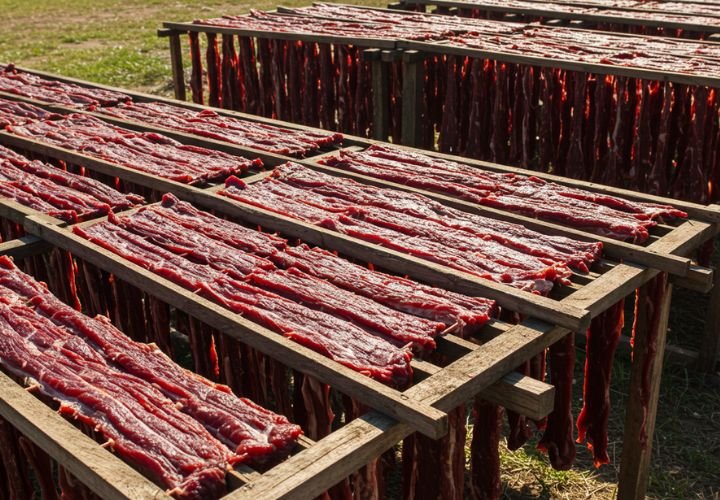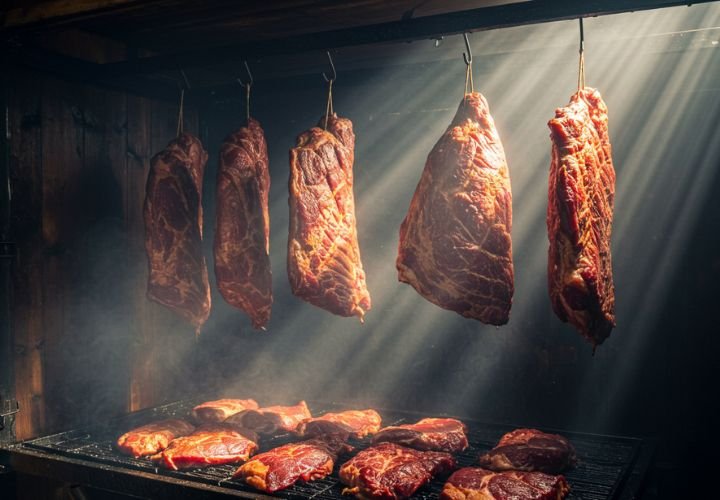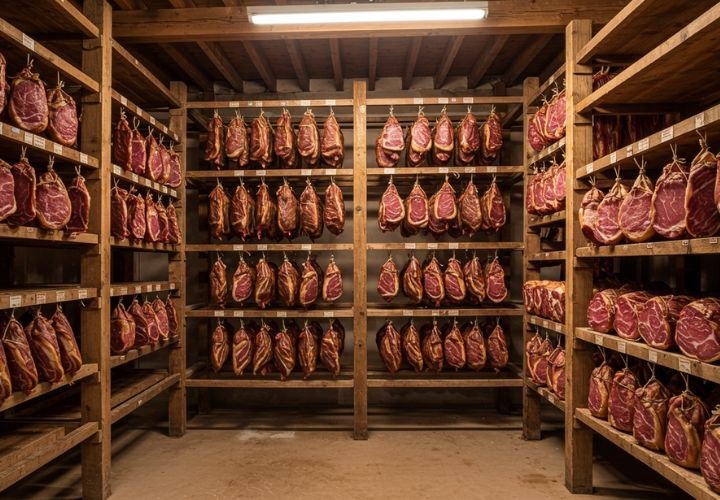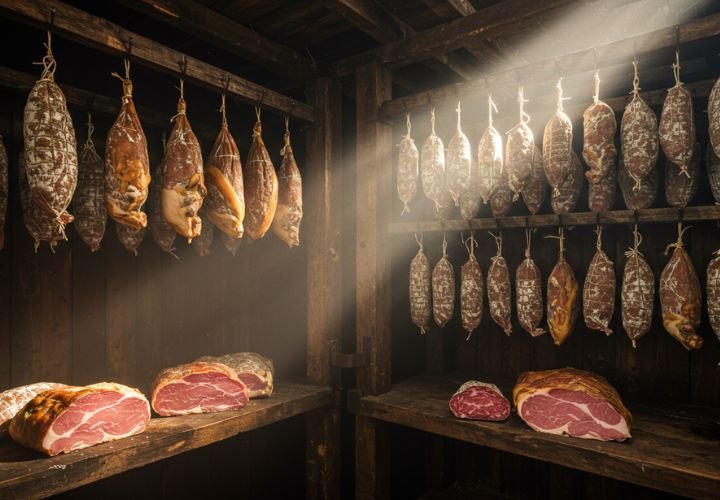Have you ever wondered how to keep meat fresh for years without a fridge? Before modern refrigeration, ancient civilizations developed ingenious methods to ensure their meat supply remained edible over time. Many of these techniques, like salting and drying, remain relevant today as sustainable and practical solutions.
In areas where meat is a dietary staple, knowing how to preserve meat without refrigeration is invaluable. Historical practices, such as smoking in Europe or sun-drying in South America, provided reliable ways to store meat for long periods. These traditional methods ensured communities had access to preserved meat during times of scarcity or limited resources.
Revisiting these approaches offers not only a glimpse into history but also modern-day applications for reducing energy reliance while maintaining the quality and nutrition of meat.
Introduction to Traditional Meat Preservation Techniques
Preserving meat has been an essential practice for survival throughout history. Over centuries, various cultures developed methods tailored to their environments, ensuring their meat remained safe to consume. From curing meats in salt to drying them under the sun, these techniques highlight the resourcefulness of our ancestors and their ability to create long-lasting solutions that are still practical today.
The Importance of Meat Preservation
The primary purpose of preserving meat is to prevent spoilage caused by bacteria and fungi. Natural meat preservation techniques, such as drying, smoking, and curing, also protect fats from becoming rancid, preserving the flavor, texture, and nutrients.
Traditional methods like smoking and salting are not only effective but also environmentally friendly. They require minimal energy compared to refrigeration and produce little to no carbon emissions. For instance, in Europe, smoked meats like sausages and hams have been staples for centuries, while sun-dried meats like charque or carne seca in South America have supported communities in warm climates with little access to refrigeration.
By applying these time-tested methods today, we can embrace a sustainable and practical approach to meat preservation.
Time-honored tradition: Wood smoke preserving and flavoring meats in a traditional smokehouse
Natural Meat Preservation Methods
Preserving meat without refrigeration involves removing moisture, preventing bacterial growth, and protecting it from spoilage. Here are the most effective natural meat preservation methods:
1. Salting and Curing
Salting, also known as curing, is one of the oldest and most reliable methods of meat preservation. By coating meat with salt, moisture is drawn out, creating an environment where bacteria cannot thrive. This method not only extends the shelf life of meat but also enhances its flavor.
- How it works: Salt dehydrates the meat and inhibits microbial growth, preventing spoilage.
- Modern application: Curing salts, such as pink curing salt, are often used to preserve meats like bacon or sausages.
- Historical example: Prosciutto from Italy is a classic example of cured meat.
Practical Example: Curing Meat at Home
What you need:
- 1 kg of pork belly or beef cut
- 50 g of kosher salt (non-iodized)
- 2.5 g of pink curing salt (optional, for long-term preservation)
- 20 g of sugar (optional, to balance flavor)
- Your choice of spices: black pepper, garlic powder, or smoked paprika
Steps:
- Prepare the meat: Trim any excess fat and pat the meat dry with a paper towel.
- Apply the salt mix: Mix the kosher salt, curing salt, sugar, and spices in a bowl. Generously rub the mixture onto the meat, ensuring every surface is well coated.
- Refrigerate: Place the meat in a resealable bag or wrap it tightly with plastic wrap. Store it in the refrigerator for 5-7 days, flipping it daily to ensure even curing.
- Rinse and dry: After curing, rinse the meat under cold water to remove excess salt. Pat it dry with a paper towel and let it air-dry for a few hours.
- Optional drying: For long-term preservation, hang the meat in a cool, ventilated space for 1-2 weeks to allow further drying and flavor development.
Result: The cured meat will be ready to slice and enjoy as a savory addition to meals or snacks. Properly cured meat can last for months when stored in a cool, dry place.

2. Drying and Sun-Drying
Drying meat is one of the simplest and most effective ways to preserve it, as it removes moisture that bacteria need to grow. In warmer climates, sun-drying has been a traditional practice, while in cooler areas, air-drying in well-ventilated spaces has been preferred for centuries.
- How it works: Thinly sliced meat is exposed to air or sunlight until it becomes dry and hard, preventing spoilage.
- Modern application: Jerky, made from beef, chicken, or even game meat, is a popular example of dried meat enjoyed globally.
- Historical example: Charque or carne seca from South America was a staple for communities in tropical climates, offering a reliable protein source.
Practical Example: Sun-Drying Meat at Home
What you need:
- 1 kg of lean beef (fat is removed to avoid spoilage)
- 1 tbsp of salt
- Optional: 1 tsp of spices (cayenne pepper, garlic powder, or smoked paprika)
- A drying rack or string to hang the meat
Steps:
- Prepare the meat: Slice the beef into thin strips, about 1 cm thick and 10-15 cm long. Ensure all pieces are of uniform size for even drying.
- Season the meat: Rub the salt (and spices, if desired) evenly onto the strips. Let the meat sit for 30 minutes to allow the salt to penetrate.
- Set up the drying area: Choose a sunny, well-ventilated spot. Place the meat on a drying rack or hang it using string. Protect it from flies and insects by covering it with a fine mesh or net.
- Sun-dry the meat: Allow the meat to dry in direct sunlight for 2-3 days. Turn the strips occasionally to ensure even drying. The meat is ready when it becomes firm and slightly brittle.
- Store the dried meat: Store the dried strips in an airtight container or vacuum-sealed bag. Keep them in a cool, dry place for up to several months.
Result: You’ll have a batch of naturally preserved, protein-rich dried meat perfect for snacking or cooking. Sun-drying not only enhances the shelf life of meat but also intensifies its flavor.

3. Smoking
Smoking is a time-tested method that combines drying with the natural antibacterial properties of wood smoke. This technique not only preserves meat but also infuses it with rich, smoky flavors, making it a favorite across cultures.
- How it works: Meat is exposed to smoke from burning wood, which dehydrates it while coating the surface with antimicrobial compounds that prevent bacterial growth.
- Modern application: Smoked sausages, hams, and fish remain widely consumed delicacies around the world.
- Historical example: In northern Europe, smoking was essential for preserving meats during cold winters, ensuring communities had a reliable protein source.
Practical Example: Smoking Meat at Home
What you need:
- 1 kg of meat (beef, pork, or fish works well)
- 1 tbsp of salt (for seasoning and pre-curing)
- Optional: Spices or a marinade for added flavor
- A smoker or a makeshift setup with a grill and a lid
- Hardwood chips (oak, hickory, or applewood for flavor)
Steps:
- Prepare the meat: Slice the meat into manageable pieces, about 2-3 cm thick. Rub the salt (and any spices or marinade) evenly over the meat. Let it sit for at least 30 minutes to absorb the seasoning.
- Set up the smoker: Use a dedicated smoker or create a makeshift one using a grill with a lid. Place the hardwood chips in the smoker or directly on the hot coals to generate smoke.
- Start smoking: Arrange the meat on the racks, ensuring the pieces don’t overlap. Close the smoker or grill lid to trap the smoke and maintain a steady temperature between 70-90°C (160-200°F).
- Smoke the meat: Allow the meat to smoke for 4-6 hours, depending on the thickness. For safety, ensure the internal temperature of the meat reaches 65-70°C (150-160°F).
- Cool and store: Once the smoking is complete, let the meat cool to room temperature. Store it in an airtight container or vacuum-sealed bag in a cool, dry place.
Result: Smoked meat can last several weeks to months, depending on how it’s stored. The smoky flavor and enhanced texture make it a delicious addition to meals or snacks.
Benefits of Preserving Meat Without Refrigeration
Preserving meat without refrigeration offers a range of advantages, from cost savings to environmental sustainability and health benefits. Let’s explore these benefits in detail:
1. Cost-Effective and Energy-Saving
Natural meat preservation methods eliminate the need for energy-intensive refrigerators or freezers. This leads to significant savings on energy bills and reduces the cost of setting up and maintaining refrigeration systems.
For households in off-grid areas or during power outages, these methods are invaluable. They provide reliable ways to store meat without the dependency on electricity.
2. Environmentally Sustainable
Preserving meat without refrigeration aligns with global efforts to reduce carbon emissions and combat climate change. Refrigeration and freezing systems consume large amounts of energy, contributing to a higher carbon footprint.
Natural methods, such as drying, smoking, or salting, are low-energy alternatives that promote sustainability. With the growing demand for eco-friendly solutions, these techniques support the movement towards reducing power consumption and greenhouse gas emissions.
3. Avoidance of Artificial Preservatives
One of the key benefits of traditional and natural preservation methods is the avoidance of artificial additives. These methods use simple, natural ingredients like salt, spices, and smoke, which enhance flavor without compromising health.
For instance, some modern advancements, like heat-based preservation by Tereos, reduce water content in meat analogs to extend shelf life without introducing harmful chemicals. This makes them ideal for those seeking healthier, additive-free options.
4. Demonstrated Effectiveness of Natural Solutions
Research and innovation continue to validate the effectiveness of natural preservation methods. For example:
- Shenyang Normal University developed a formula that preserves meat analogs for up to 56 days without refrigeration.
- Renegade Foods offers vegan meat products that maintain texture and flavor at room temperature, showcasing the potential of plant-based and natural preservation methods.
5. Shelf Life Comparison of Preservation Methods
The table below highlights the differences in shelf life across various preservation methods:
| Preservation Method | Product | Storage Life |
|---|---|---|
| Freezing | Beef | 6 to 12 months |
| Freezing | Lamb | 6 to 9 months |
| Freezing | Pork | Up to 6 months |
| Drying | Jerky | Indefinite |
| Canning | Processed Meat | Indefinite |
| Natural Preservation | Meat Analogs | 56 days |
As seen, natural preservation methods like drying or canning offer incredibly long shelf lives while eliminating the need for energy-intensive freezing.
The Science Behind Meat Preservation
The science of meat preservation addresses spoilage caused by bacteria and fungi, combining traditional and modern methods to keep meat fresh, safe, and nutritious. These techniques are vital for preserving meat without refrigeration.
Traditional Meets Modern Techniques
From sun-drying and curing to high-pressure processing and dry-aging, preservation methods have evolved significantly. Traditional techniques like smoking and fermentation have stood the test of time, while modern innovations like high-pressure processing (HPP) offer new ways to extend shelf life and maintain quality.
How Preservation Methods Work
- Curing and Smoking: These methods not only prevent spoilage but also enhance flavor. Chemical processes, such as the conversion of nitrate to nitrite, help preserve the meat and improve its taste.
- Fermentation: Using lactic acid bacteria creates unique flavors while extending shelf life naturally.
- Dry-Aging: Aging beef in a controlled environment for 28-55 days enhances its tenderness, flavor, and juiciness.
- High-Pressure Processing (HPP): By applying high pressure, this method keeps meat’s nutritional value intact while improving tenderness and digestibility.
| Technique | Description | Benefits |
|---|---|---|
| Dry Aging | Controlled aging of meat in a humidified chamber for 28-55 days. | Enhanced flavor, tenderness, juiciness |
| High-Pressure Processing | Application of high pressure to mature meat. | Maintains nutritional value, improves digestibility and tenderness |
| Fermentation | Use of lactic acid bacteria to preserve meat. | Distinctive flavors, extended shelf life |
Knowing the science of meat preservation is key in the food industry. Whether it’s ancient practices or modern tech, these methods keep meat safe and tasty.

Long-Term Storage Solutions for Preserved Meat
Proper storage is critical for maintaining the quality and safety of preserved meat over time. By using the right methods and monitoring conditions, you can significantly extend its shelf life while ensuring it remains safe to eat.
Optimal Storage Conditions
Preserved meat requires a stable environment to remain in good condition. A cool, dry place is ideal, with consistent temperatures and low humidity to prevent spoilage or mold growth. For example, dried meat should be stored at 50°F to 60°F in low-humidity environments.
Use basements or dedicated storage spaces for long-term preservation. To maintain dryness, consider using tools like silica gel packets or dehumidifiers. Vacuum-sealed bags are particularly effective at keeping out air and moisture, further prolonging the meat’s shelf life.
Monitoring and Maintenance
Regularly inspecting your preserved meat is essential to detect early signs of spoilage and maintain quality. Here are the key steps:
- Frequent Checks: Look for discoloration, unpleasant odors, or mold growth.
- Proper Labeling: Always label the preservation date and method to track storage times and prioritize older items.
- Consistent Conditions: Monitor temperature and humidity levels in the storage area with tools to ensure a stable environment.
Selecting appropriate containers is equally important. Glass jars work best for canned meat, while vacuum-sealed bags or butcher paper are ideal for dried, salted, or smoked meat. A rotation system (“first in, first out”) helps ensure older items are used before newer ones.
| Preservation Method | Ideal Temperature | Recommended Container | Inspection Tips |
|---|---|---|---|
| Dehydration | 50°F – 60°F | Vacuum-Sealed Bags | Check monthly for moisture or mold |
| Canning | 68°F – 72°F | Sterilized Glass Jars | Check seals and dates |
| Salting | Cool, Dry Place | Salt Crust or Airtight Jars | Monitor for odors and salt reformation |
| Smoking | Up to 75°F | Butcher Paper or Vacuum Bags | Inspect for dryness and mold |
How to Incorporate Preserved Meat into Your Diet
Preserved meat is both practical and versatile, making it easy to include in everyday meals. Here are some ideas to get started:
Healthy Recipes with Preserved Meat
- Pork Fluff:
- Ingredients: 1.5 lbs lean pork loin, 1/4 cup light soy sauce, 2 tbsp dry sherry, spices.
- Instructions: Mix all ingredients and cook on low heat until dry and fluffy. Store in an airtight container and pair with leafy greens for a balanced meal.
- Dendeng:
- Ingredients: 2 kg round steak, peanut oil, spices.
- Instructions: Cook steak with oil and spices on low heat for 30-35 minutes. Bake until dark brown. Store in a cool, dry place for later use.
Simple Meal Ideas
- Salads: Add thin slices of preserved meat for a protein-rich topping.
- Soups and Stews: Use preserved meat as a flavorful base ingredient.
- Wraps and Sandwiches: Combine preserved meat with fresh vegetables and herbs for a satisfying meal.
Conclusion
With proper storage and creative meal ideas, preserved meat can remain safe and delicious for months or even years. By monitoring storage conditions and incorporating preserved meat into your diet, you can enjoy its flavor, versatility, and practicality—making it an essential part of sustainable living.
FAQ
1. What are the key benefits of preserving meat without refrigeration?
Preserving meat without refrigeration is cost-effective, eco-friendly, and reduces reliance on artificial preservatives. It maintains the nutritional value and flavor of meat while supporting sustainable living.
2. What are the best methods to preserve meat naturally?
Drying, smoking, curing, and fermentation are some of the most effective natural methods. These techniques remove moisture, prevent bacterial growth, and enhance flavor without the need for refrigeration.
3. Can any type of salt be used for curing meat?
Not all salts are ideal for curing. While table salt, sea salt, and curing salt can be used, curing salts (like pink salt) are specifically formulated for long-term preservation and food safety.
4. What tools are necessary for preserving meat?
Essential tools include a drying rack or dehydrator for drying, a smoker for smoking, airtight containers or vacuum-sealed bags for storage, and curing salts for salting meat.
5. What are the optimal storage conditions for preserved meat?
Store preserved meat in a cool, dry place with stable temperatures between 50°F and 60°F. Use sealed containers or vacuum bags to block moisture and prevent contamination.
6. How can I tell if preserved meat has gone bad?
Inspect your preserved meat regularly for signs of spoilage, such as discoloration, unpleasant odors, mold, or changes in texture. If you notice any of these, discard the meat immediately.
7. Why is understanding the science behind meat preservation important?
Understanding the science ensures proper use of preservation techniques, helping to maintain safety, extend shelf life, and preserve nutrients in meat effectively.
8. How can preserved meat be included in daily meals?
Preserved meat is versatile and can be used in soups, stews, salads, sandwiches, and wraps. Pair it with fresh vegetables, grains, or herbs for balanced and flavorful meals.


